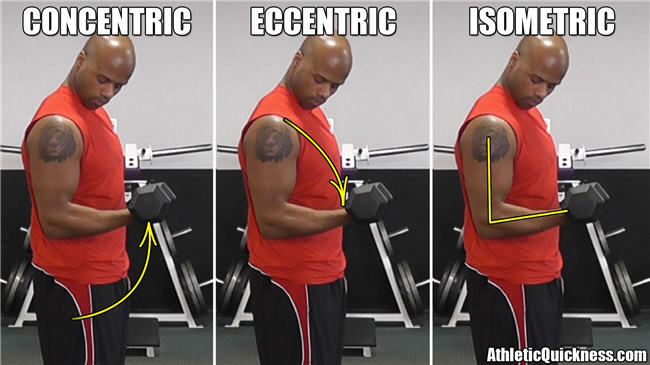The 3 Types of Muscle Contractions Concentric, Eccentric, and Isometric
Your speed training program will deliver your best sports performance when you train your muscles with all three!
Part 1 of 4
Part 1 – Muscle Contraction Types
Weight training, plyo training and cardio training, as effective as they are, only incorporate concentric and eccentric muscle contractions and therefore, if that is the extent of your speed training, you will be missing out on the third key ingredient in sports training, known as isometric contractions.
Sports skills have very dynamic movements and with varying body positions; and, by training your muscles for every position and movement in the sport skill you give yourself the greatest opportunity to succeed.
Think how good you will feel and perform when your muscles have been conditioned using all three types of muscle contractions. Each contraction type plays a part in developing or performing most every sports skill – including running, jumping, kicking, swimming strokes, swing a bat, tennis racket, golf club, or hockey stick.
When talking about exercise, most people generally do not speak in terms that describe the type of muscle contractions (concentric, eccentric, isometric) they are going to put their muscles through, but rather, they tend to speak in terms that describe the exercise itself.
For example, people generally tend to say they are going to lift weights, such as bench press, lateral pull-downs and maybe some biceps curls. You may also hear them say they are ‘doing cardio today’ which implies running on a treadmill, a bicycle and/or running on a track.
Sometimes you hear athletes say they are going to do some plyometric training which may include exercises that involve medicine balls, or jumping up and down off platforms, or perhaps lifting lighter weights at a higher pace than normal.
But with the exception of isometric training, which actually defines the type of muscle contraction, rarely will you hear, if ever, that someone is going to do some eccentric and/or concentric muscle training.
So in this article, we are going to define the different types of muscle contractions and give you examples of exercises where these types of contractions take place, and why each type of exercise is important to reach your peak sports performance level.
So let’s get started …..
Getting The Terminology Right
First, and to make matters a bit more complicated, the term contraction, when used with the word muscle, as in muscle contraction, is generally understood by most as a shortening or reduction in muscles’ length – and this is the dictionary definition.
However, with athletics and fitness training, this definition doesn’t take into account the dynamic nature of a muscle to work while being forced in the opposite direction, as in muscle lengthening, nor does it take into account a muscles dynamic ability to work while remaining in a fixed position.
So while the words muscle contraction have taken on a broader meaning in the athletic fitness world, the actual definition of the word contraction, as defined in the dictionary, is a bit of a misnomer when talking about the different types of muscle “contractions”.
What are the 3 types of muscles contractions?
So, the term tension, rather than contraction, is better suited to define the actions (dare I say, contractions!) of a muscle.
Therefore, muscles, under tension, may:
- Shorten,
- Lengthen, or
- Remain the same length.
It is these three different types of muscular tensions that are used to define the three different types of muscular “contractions.” The three different types of muscular contractions, therefore, are:
- Concentric contractions (shorten)
- Eccentric contractions (lengthen)
- Isometric contractions (remain the same)
Concentric Contractions
A concentric contraction is a type of muscle contraction when the length of the muscles shorten while undergoing tension.
For example, when you pick up a curl bar and perform a biceps curl, the length of your biceps muscles shorten. Your hands start down by your sides, and ends with your hands up by your shoulders. The biceps muscles shorten during this motion.
Another example would be if you were to perform a couple of leg curls on a hamstring machine. As your knee is flexing, your foot is approaching your buttocks, and your hamstring muscles shorten in the process.
Any muscle activity where the strength of the muscle can overcome the resistance of an object forcing the muscle’s length to shorten, is considered a concentric contraction.
Therefore, most of the exercises that you would typically do at a gym by using the various machines and/or dumbbells, etc. involve concentric contractions.
Eccentric Contractions
An eccentric contraction is a type of muscle contraction when the length of the muscle elongates, or lengthens while undergoing tension.
This can occur in two different ways:
- a) Voluntarily Contractions
b) Involuntarily Contractions - a) Voluntary Eccentric Contractions Using the same example above for the biceps curl, after you have completed the first part of the biceps curl, when your elbows are flexed, and your hands are holding on to the curl bar up by your shoulders, it is now time to return the weight back down towards your waistline.
Typically this is done in a smooth and controlled motion where the muscle, the biceps, acts to decelerate the elbow joint at the end of the movement.
The same muscle that started this motion, the biceps, is now undergoing tension in the opposite direction. It is now lengthening as it returns the weight back down towards your waist. This is an example of a voluntary eccentric contraction.
Another similar example involves the hamstring muscles. Like the example above involving leg curls, as you return the weight back to its starting point, the knee joint extends slowly with the aid of the hamstrings.
These muscles undergo tension, but now in the opposite direction, where they are lengthening. This is another example of a voluntary eccentric contraction.
- b) Involuntary Eccentric Contractions Involuntary eccentric contractions occur when the weight or resistance you are attempting to move or lift is too heavy or strong for the muscle to accommodate. The main difference between this, and the voluntary eccentric contractions, is the lack of control over the weight/resistance during an involuntary eccentric contraction.
We can use a similar example for involuntary eccentric contractions as we did for the voluntary eccentric contractions.
Using the biceps curl exercise, when you have both of your elbows flexed, with your hands up by your shoulders, and someone hands you a 100 lb. barbell, the average person handed this weight, (if they don’t just drop it) would immediately have their biceps muscles lengthened, even if they tried to prevent it by tensing them. This would be an example an involuntary eccentric contraction.
It should be noted that muscles subjected to heavy involuntary eccentric loading beyond your control can suffer potentially greater damage when overloaded as compared to concentric (muscle shortening) and/or voluntary eccentric loading.
Voluntary eccentric contractions are just as much a part of weight training as are concentric contractions. A concentric contraction is typically associated with the exercise itself, as in biceps curls, triceps push downs etc.
But, concentric contractions only account for half of the repetition of that particular exercise. (for example, biceps curl – the muscle shortens under tension while the elbow is flexing). The other half, the returning of the weight to the starting position, is controlled through voluntary eccentric contractions. (for example, biceps curl – the muscle lengthens under tension while the elbow is extending)
Many times, however, exercises are purposely designed around a slow return of the weight back to its starting position only. This is what is termed as negatives with respect to weight training.
And, it is a known fact that muscles are typically stronger during voluntary eccentric movement (muscle lengthening) when compared to a concentric movement (muscle shortening).
To understand why this is, just think that it is much easier to set a 100 lb package to the ground than it is to raise one up off the ground.
Weight training therefore, involves concentric muscle movements, voluntary eccentric muscle movements, and occasionally, involuntary eccentric movements.
Isometric Contractions
An isometric contraction is a type of muscle contraction where the length of the muscle doesn’t change while undergoing tension. For example, when you take a 20 pound weight and perform a biceps curl and hold a position halfway between the repetition for 10 seconds. The length of your biceps muscle doesn’t change during this time, alyough a force is still being applied.
Another example would be if you were to push against a wall for 10 seconds. The wall doesn’t move and neither does the length of the muscles in your arms pushing against it. Again, a force is still being applied.
Training with All Three Types of Contractions
A complete speed training program would not be considered complete without incorporating, to some extent, each of the three different types of muscle contractions mentioned thus far. They all play a part in improving sports performance.
Many athletes who have been training for speed believe they “have tried everything” and are having difficulty getting faster. Often they are missing the final piece of the puzzle because they have not incorporated into their speed training all of the muscle contraction types.
Simply knowing these different types of muscle contractions will go a long way in helping an athlete design a complete speed training program that delivers increased athletic and sports performance.
Like building a wrist watch, you can have all the parts, gears, screws, etc., but your watch may not work very well. But, if you add a simple spring, you have not just added one more thing, you have a whole system that works in harmony – and, in the case of athletics, it would have an exponential effect on your speed and performance training.
In part 2 or this article, we will discuss some of the different types of exercises available today, including weight training, plyometric training, and cardio training, to name a few, and identify for you the types of muscle contractions involved with each of them.
Once you know the type of muscle contraction(s) involved with each of these training methods, you will gain a better appreciation for what each of them has to offer by way of improving your overall athletic performance.
Part 1 – Muscle Contraction Types
Always glad to help!
Dr. Larry Van Such






